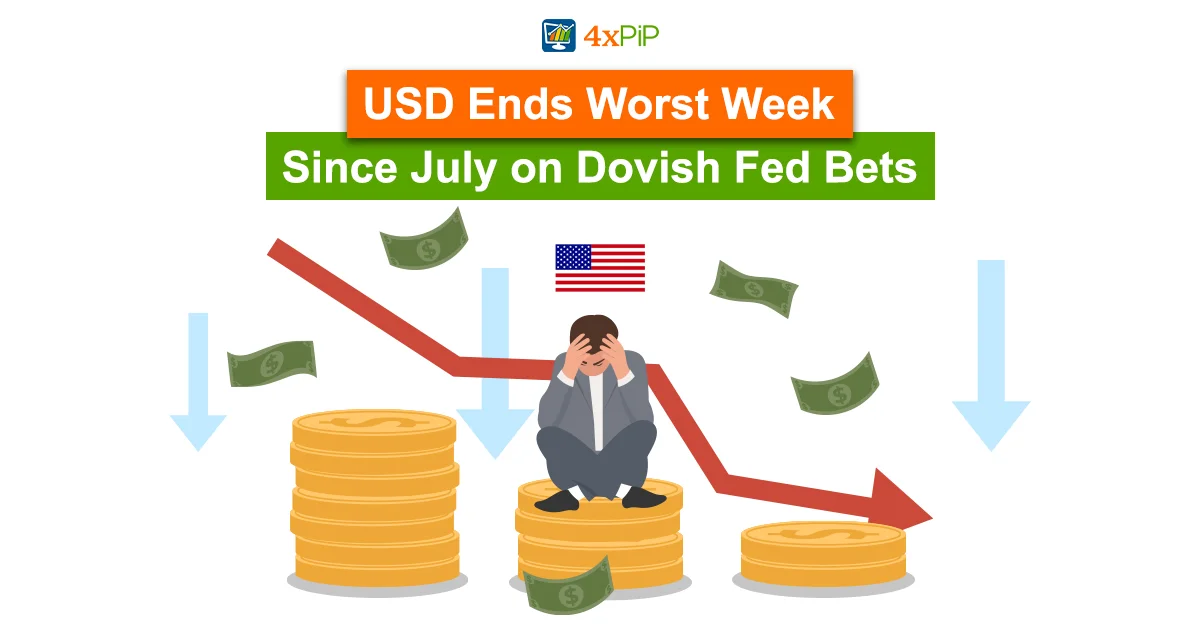As the financial markets end a turbulent week, the US Dollar faces scrutiny, closing its worst week since July. Investors navigate twists influenced by bets on a dovish Federal Reserve. Explore the key events, economic indicators, Fed’s stance, market outlook, and a comprehensive summary of the week. For insights into navigating market shifts and enhancing trading strategies, turn to 4xPip. Reach out to experts at [email protected] for guidance and explore tools to optimize trading.
Recap of the Week:
The past week presented a formidable challenge for the US Dollar (USD), marking its most challenging performance since July. The DXY Index, serving as a barometer for the USD against major currencies, logged a 1.60% decline, closing at 103.90 with a daily loss of 0.40%. The primary culprits behind this downward spiral were softer-than-expected inflation figures and a sluggish showing in the US economic arena.
In October, the Core Consumer Price Index (CPI) missed expectations, settling at 4% YoY instead of the anticipated 4.1%. Concurrently, the Core Producer Price Index (PPI) fell short of projections, recording a 2.4% YoY figure. Despite Retail Sales surpassing expectations with a modest 0.1% MoM decline compared to the predicted 0.3%, other economic indicators, such as Initial Jobless Claims and Industrial Production, hinted at potential challenges in the labor market and a contraction in industrial activities. These signals contributed to an overall dovish sentiment. Adding nuance to the market dynamics, Susan Collins of the Federal Reserve introduced a hint of hawkishness during the week. As the week concluded, the USD grappled with uncertainties, closing at 103.90. Traders and investors were left contemplating the evolving economic landscape and the shifting stance of the Federal Reserve.
Economic Indicators and Data Highlights:
The week’s economic indicators presented a mixed landscape, contributing to the USD’s challenging week. Notably, the Core Consumer Price Index (CPI) for October fell slightly below expectations, standing at 4% YoY instead of the anticipated 4.1%. This signaled a moderate deceleration from its previous figure of 4.1%, indicating a nuanced inflationary environment. On the positive side, Retail Sales for October outperformed expectations, showcasing a decline of only 0.1% MoM, contrary to the predicted 0.3% decline. This unexpected resilience in retail sales hinted at underlying strength in consumer spending, countering some of the prevailing economic concerns.
However, challenges persisted as Initial Jobless Claims for the week ending November 11 exceeded predictions, rising to 231,000 against the anticipated 220,000. This uptick in jobless claims suggested potential challenges in the labor market. Industrial Production in the United States faced headwinds, experiencing a 0.6% MoM decline, surpassing the expected -0.3%. The year-over-year decrease of 0.7% indicated broader concerns about the health of the industrial sector. Despite these hurdles, Housing Starts and Building Permits for October emerged as bright spots, surpassing expectations and injecting a degree of optimism into the economic narrative.
Key Economic Highlights:
- Core Consumer Price Index (CPI) for October at 4% YoY, slightly below expectations.
- Retail Sales for October outperformed, showing a modest decline of 0.1% MoM.
- Initial Jobless Claims increased to 231,000, surpassing predictions of 220,000.
- Industrial Production faced challenges with a 0.6% MoM decline and a 0.7% YoY decrease.
- Housing Starts and Building Permits from October exceeded expectations, providing a positive note amid economic uncertainties.
- As traders and investors navigated these economic indicators, the varying signals added complexity to the market sentiment, influencing the USD’s performance throughout the week.
Federal Reserve’s Stance:
The Federal Reserve’s stance during the week played a crucial role in shaping market dynamics. Notably, Fed’s Susan Collins, while expressing a hawkish tone on Friday, emphasized that further tightening was not completely off the table. This nuanced statement injected a degree of uncertainty into the market. Despite the hawkish sentiment, the market largely interpreted the overall stance of the Federal Reserve as dovish.
Market participants closely watched the central bank’s signals amid economic data pointing to cooling inflation and a tepid labor market. The odds of a 25-basis-point hike in December were reported to be zero according to the CME FedWatch Tool. Investors speculated on rate cuts appearing sooner than anticipated, potentially in May 2024 or March. These factors created a complex sentiment around the Federal Reserve, contributing to a dovish outlook and impacting the market’s perception of the US Dollar.
Market Outlook and Technical Analysis:
Looking ahead, the market is cautiously optimistic, balancing on the edge of uncertainty. Traders and investors are closely monitoring key support and resistance levels to gauge the potential trajectory of the US Dollar. From a technical standpoint, the USD exhibits a bearish bias, with sellers firmly in control. The Relative Strength Index (RSI) signals a bearish outlook, indicating the potential for further downward movement. Additionally, the Moving Average Convergence (MACD) histogram displays a series of rising red bars, underscoring the prevailing bearish sentiment.
Monitor key support levels at 103.80, 103.60 (200-day SMA), and 103.30. These points may act as turning points in the market. On the other hand, pivotal resistance levels at 104.15 (100-day SMA), 104.50, and 105.00 could impede or redirect the USD’s descent. Navigating this challenging terrain, traders find valuable insights through technical analysis, aiding them in making well-informed decisions based on prevailing market dynamics.
Summary:
In a week marked by twists and turns, the US Dollar (USD) faced its toughest performance since July, closing with a 1.60% decline and settling at 103.90 against major currencies. Soft inflation figures, a stumbling labor market, and a nuanced Federal Reserve (Fed) stance contributed to this challenging scenario. Economic indicators presented a mixed picture, with the Core Consumer Price Index slightly below expectations but Retail Sales showing unexpected resilience. The Fed, led by Susan Collins’s hawkish tone, added a layer of uncertainty. Looking ahead, the market maintains a cautious optimism with a bearish technical bias for the USD, emphasizing the importance of monitoring critical support and resistance levels.





